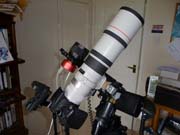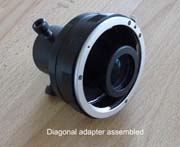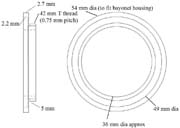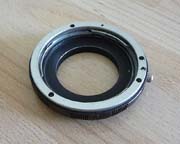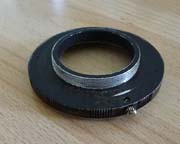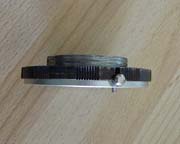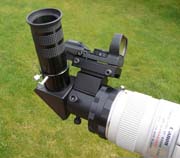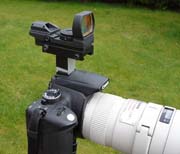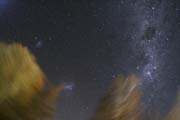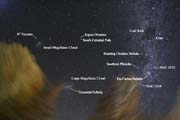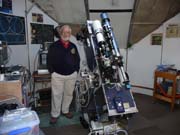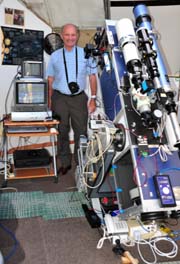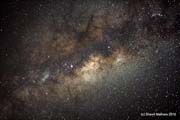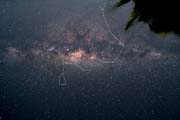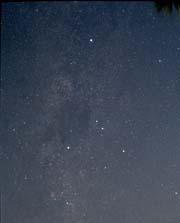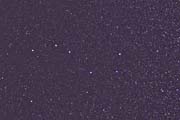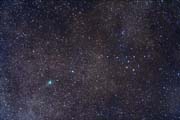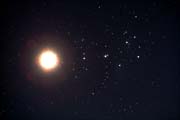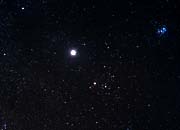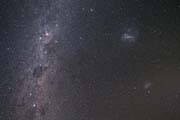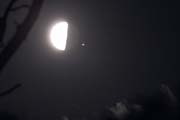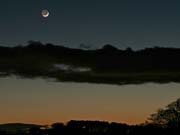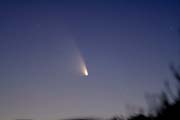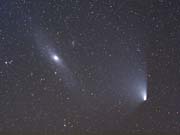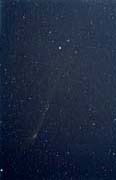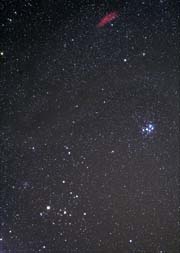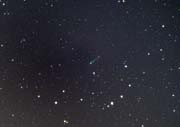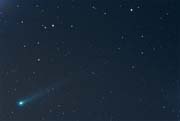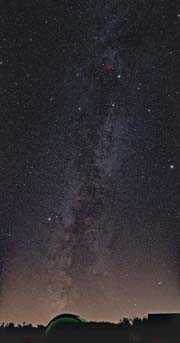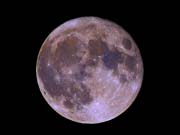As the Eclipse/Southern Hemisphere trip in June/July 2010 grew closer, I became increasingly concerned about the weight problems in taking the originally planned set up for eclipse and astro photography using my Series 5000 80 mm refractor on my EQ3-2 mount. I considered a premium small refractor, but after considerable web browsing, in particular this site, I invested in the superb Canon EF 400 f5.6L prime telephoto lens. I also managed to reduce the size of the guiding system by using a small 300mm fl mirror lens which strangely although supposedly M42 lens thread screwed easily into the 'T' threaded XY guider without an adapter.
Total weight saving a little over 3 Kg. Doesn't sound much, but with airline weight restrictions....
The lens has a built in retracting hood about 75 mm deep when extended - very useful for protection and stray light exclusion as well as dew prevention. The rig as shown here is in deep sky guiding mode, but for the eclipse photography only the 400L will be used. The odd looking object mounted on the camera 'hot shoe' is a red dot finder for night time use.
Postscript. Would you believe after all that, shortly before the trip I was informed that our luggage allowance was almost twice that originally expected. So no need for the weight worries and I could have stayed with the 80 mm telescope! But in the end I didn't take the 80 mm - even with three suitcases our weight was on the limit for each case, and four cases would have been unmanageable when travelling, particularly in the Motor Caravan in New Zealand! We had a fantastic holiday. Here.
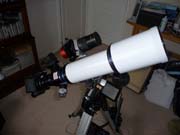
Of course having bought the 400L lens, I had to test it with the Canon 350D camera. A sequence of 15 x 5 minute sub frames, ISO 800 at f6.3 yielded this shot of M81 and M82.
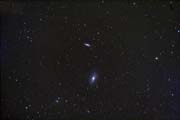
The owner of the 'shootout' site, also devised a system whereby using a Barlow type lens it is possible to use a diagonal and eyepiece. Details here. So I fired up my lathe and made a similar item using the bayonet adapter and other parts of a remarkably cheap but well made extension tube macro ring.
These are readily available on the Internet, particularly Amazon and ebay. Search for 'Macro Extender', be sure to get the correct pattern for your make of camera lens. No need for one with internal wiring. Works well, and I was also able to make a fitting to use the lens with my ST4000 XCM. Unfortunately not enough back focus for the ST-10 with filter wheel.
Later. I eventually managed to make a slimmed down version of the lens adapter which *does* allow the 400 mm lens to reach focus with my ST-10. But only just - my Tamron zoom lens which I used for the wide angle Milky Way shots below still doesn't provide quite enough back focus.
The bayonet section had to be trimmed, losing the spring for the locking pin - an elastic band takes care of that in use! And the insert is very thin to allow the lens to fit - the web is only 0.5 mm! But it does the job. It's epoxied in place, but if I were to make another one I'd probably thread it and the bayonet housing for a more secure fixing, also using epoxy resin or superglue to prevent unscrewing.
Later again (January 2012) My new QSI camera with the ws front fitted allows my Tamron lens to reach focus! The 'T' thread on my home made adapter which only just held firm on my ST-10 was not good enough for the QSI fitting. But a few hours in my workshop and a new part did the trick.
The focal length of the lens with the Barlowed system is around 1300 mm, so a finder is necessary. There was just enough room to fit a red dot unit on the adapter! I had earlier cobbled up a finder mounting block for my camera as also seen in the main picture, so all set :-)

A further experiment with the 400L lens bore fruit! The already good photographs are even sharper when the lens is stopped down to f6.3 or even f7.1 But this introduces substantial diffraction 'Star bursts' on bright stars due to the diaphragm blades. I found that by stopping down the lens using an external mask I obtained images even cleaner than with the diaphragm, and without star bursts. A modified lens cap makes an excellent removable mask, and has the advantage that if I am using the lens with my ST-4000XCM I don't need the Canon camera available to preset the stop.
The star featured here is 2nd magnitude eta Bootis. This system seems to work well on most prime lenses, but experiments with zoom lenses showed substantial vignetting.

